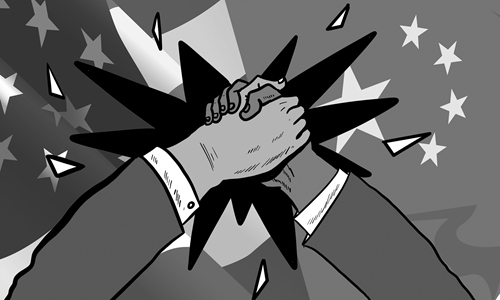HOME >> SOURCE
Expectations for trade deal should be kept realistic
By Wang Cong Source:Global Times Published: 2020/1/13 23:17:15

Illustration: Luo Xuan/GT
As the Chinese delegation led by Vice Premier Liu He left Beijing for Washington on Monday to sign the phase one agreement later this week, global markets turned their attention to what the highly anticipated deal will bring and where the China-US trade relationship is headed.Such broad attention is appropriate, given the grave damage of the trade war on businesses around the world. However, it is also paramount for all to manage their expectations for the interim agreement and continue to prepare for risks that might emerge even after the signing of the deal.
This is not to diminish the significance of the first concrete agreement reached by Beijing and Washington in the nearly two-year trade tussle. The deal in itself will undoubtedly bring benefits to businesses in a wide range of sectors from agriculture to energy. More importantly, it will shed much-needed light on the otherwise dark outlook for the China-US relationship.
Still, as we cheer such a change of tone from the world's two biggest economies, we should also be aware of the uncertainties that could lie ahead and prepare for risks and challenges that could arise.
The most immediate and arguably the most important step for both sides after the signing ceremony at the White House is to implement the agreement. Unless both sides follow up on their commitments strictly and fully, the agreement, to put it bluntly, will just be a piece of paper.
Unfortunately, experience tells us that the US can be very unreliable and unpredictable in agreements. If evidence is needed, just look at the now-defunct North American Free Trade Agreement among the US, Canada and Mexico, as well as the Iran nuclear deal between Tehran and several major world powers.
Details of the phase one agreement are still unknown, but this much we know: China will purchase a certain amount of US products, including agricultural goods, while the US will roll back its punitive tariffs on Chinese products in phases.
China will surely follow up its commitment to increase imports from the US, once barriers such as tariffs and other administrative measures are lifted, because that is in line with the growing demand in the Chinese market for high-quality products.
It is hoped that the US will also make good its promise to remove the tariffs, which are punishing for not only Chinese businesses but also its own industries. However, there remains uncertainty given the US' track record of back-pedaling and its heavy reliance on tariffs in the trade war. Toxic US domestic politics during a heated election season are adding to the uncertainty, and anti-China rhetoric could run amok during the campaign.
On other possible issues ranging from intellectual property rights to technology transfers, China will also be able to make good on its promises because China has already put in considerable efforts, and it plans for more in these areas. Still, disputes in these areas could emerge as the US has in the past ignored facts to promote false narratives favorable to its ill-intentioned containment of China's rise.
Such tremendous uncertainty involving the China-US trade relationship calls for proper management of expectations and precautions against all scenarios after the phase one agreement.
The author is a reporter with the Global Times. bizopinion@globaltimes.com.cn
Posted in: COLUMNISTS